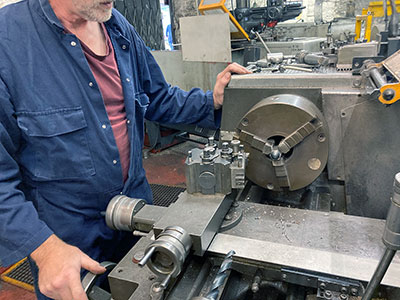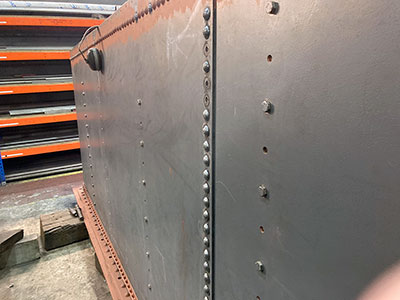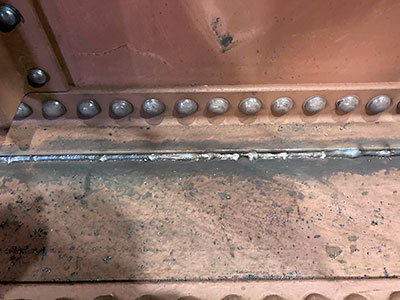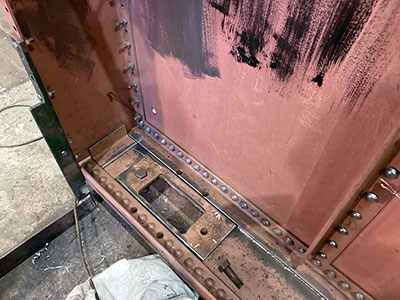
October 2023 update
By Pete Maddicks and Tony Howard
I have not been able to get to Bridgnorth much this month as my better half and I have had covid, and it obviously likes us so much that it took over two weeks to get rid of! The boys have been beavering away on several different jobs. Tony as usual will give you a detailed account of what has been going on.
I have included a photo of 2968 setting off on one of its test runs to Hampton Load. I took this photo from home off the SVR webcam, therefore as a screenshot it is not at clear as I would like. I would like to pass on my congratulations, on behalf of the 4150 gang to all the team, both full time, and volunteers on a job well done.
Monday 2nd October
Bob L, Charles L, Dave Mc, Peter M, Steve T, Tony H.
More work done on the regulator box to get it water tight for its hydraulic test. We will need to get another shut off valve as the one we have got is leaking.
After another riveting session last Thursday, it was found that we need some shorter 10mm rivets. The ones we have are 40mm long, and we need quite a few 36mm long. It was decided we need a jig making to cut the rivets to the right length. Tony found a piece of hexagonal steel on the scrap pallet just the right size. A piece was cut off on the bandsaw 38mm long and Steve machined it to the right length, put a 10mm hole through the middle on the lathe. This was taken back to the fruit D and a 6.5mm hole was drilled, tapping size for 5/16" Whitworth, and threaded. This will stop the rivet turning in the jig when cutting to length. Charles had welded a small length of round bar across a 5/16" Whitworth bolt. We were pleased with our efforts so we made a second jig so two people can cut rivets to length. We will need around 200 rivets to finish the job.
Saturday 7th October
Kevin S, Steve M, Tony H.
More 10mm rivets were cut to length using the jig that was made last week. We will need at least 50 of them for the next riveting session next week. Paint was applied on the left-hand running plate.
Monday 9th October
Charles L, Dave Mc, Peter M, Phil H, Si B, Steve T, Tony H.
Phil bought the flange that he had modified at home. It just needed the bolt holes elongating. This was done on the milling machine in the workshop.
We turned our attention to the regulator box. We had the new cut off valve which was fitted. We connected the pump to the regulator box and started to pump it up to pressure 300 psi. Before we had got anywhere near that, it was leaking from the blanking plates that were sealing off the fittings for the main steam pipes.
We tried many times to try to rectify this issue, but we could not stop water leaking. It was suggested that we wrapped electric insulation tape round the brass taper rings that seal the main steam pipes. This worked, and 300 psi was achieved, but more leaks appeared. Luckily they were on other parts where blanking off was required. The casting itself was sound. More rivets were cut to length ready for the next riveting session.
Saturday 14th October.
Kevin S, Steve M, Tony H.
We removed the front plate from the regulator box and it was decided to scrape the faces of the cover plate and the casting. There were small pieces of old gasket round the bottom of the studs. We used very fine emery cloth to clean the studs up. Hopefully this will stop the leaks when we hydraulically test this item on Monday.Steve polished the number plates on the bunker.
Monday 16th October.
Bob L, Charles L, Dave Mc, Phil H, Steve M, Steve T, Tony H.
Looking at the regulator box, the front cover plate is fitted with a combination of studs and modified bolts. We managed to remove one of these bolts on Saturday, but couldn't get any of the other six to move, and didn't want to hammer them out in case of damaging the casting. After discussing whether to have another attempt to remove them it was decided it would be beneficial to remove them as the one already removed had a lot of rust on the shank. Using a large copper mallet they were removed. Looking at the state of them we decided to replace them. Using new gaskets we did another hydraulic test. There were a few minor leaks from the blanking off plates, but the casting itself was sound and passed its hydraulic test. The overflow pipe for the 8mm injector was modified, and is ready for welding.
Saturday 21st October
Kevin S,
Only Kevin on site. He cut the rest of the rivets to the 36mm length we need, also tidied up the Fruit D.
Monday 23rd October
Bob L, Bryn T, Phil H, Steve T, Tony H.
We had the use of one of the milling machines for a hour, so the damage on the two outlets on the front plate of the regulator box was taken out. One of these outlets is not needed as it originally was connected to the Lance Cock which is no longer used. A blanking plug was obtained and screwed into the outlet. The new modified bolts that secure this plate were fitted. The left hand water tank which is currently being worked on in the boiler shop was prepared for welding along the inside bottom angle. Later, Steve and Jack K,(Boilershop staff) made a start seam welding the water tank.
Saturday 28th October
Kevin S, Simon B, Steve M, Tony H.
Kevin and Simon welded the first part of the 8mm injector overflow pipe. Tony measured the second part and cut the pipe to the correct length on the bandsaw. Simon welded the pipework together, cleaned up the welds and gave it a coat of Rustoleum. It is ready for a top coat on Monday. Steve was painting various bits and pieces.
Monday 30th October
Bob L, Charles L, Si B, Steve T, Tony H.
The 8mm injector overflow pipe was trial fitted to check the position, it was, so it was painted to top coat. Tony and Charles spoke to John, a member of the full time staff to see what was needed to be done to the regulator valve. It was examined and it needed machining as the was wear in places. John then looked at the regulator box and again it also needed machining. That meant the studs that we tried removing last week need to be removed. It was suggested that we bolt the casting to the bed of the large vertical milling machine and use a pair of stilsons. We eventually removed all six studs. More paint was applied to the two tool boxes that sit on the bunker in the cab.
2968 setting off on a test run to Hampton Load, Thursday 19th. at 14.32. Photo from SVR webcam.
Monday Steve making a jig to shorten some 12mm rivets, about 200 in all!
The seam that joins the two halves of the tank together, only a few left to do this is the job that required the shorter rivets.
The seam along the bottom has had a sealing weld to help keep the water in.
The next area all ready for welding at the next session.
This is a copy of the boiler record card for our boiler Number 5895, built in 1939, for the cost of £878!





